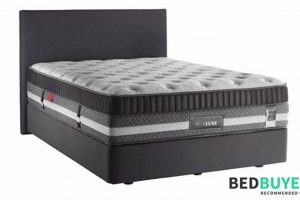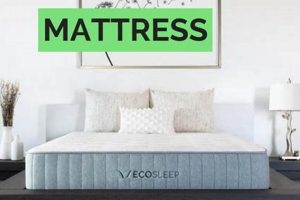The selection of an appropriate sleep surface plays a critical role in managing the discomfort associated with a chronic widespread pain condition. These surfaces aim to minimize pressure points and promote proper spinal alignment, potentially leading to improved sleep quality and reduced pain levels. Understanding the specific features and materials that contribute to these benefits is essential for informed decision-making.
A supportive and comfortable sleep environment can significantly impact an individual’s ability to achieve restorative sleep. By reducing pain and promoting relaxation, these surfaces can contribute to improved overall well-being and quality of life. Historically, individuals with this condition have sought various solutions to alleviate their symptoms, and advancements in sleep technology have led to specialized products designed to address their unique needs.
The following sections will explore the key characteristics of supportive mattresses, including materials, construction, and firmness levels. Factors to consider when choosing a mattress, such as individual sleep preferences and specific pain locations, will also be discussed. Finally, an overview of available options and recommendations based on research and expert opinions will be presented.
Guidance for Selecting a Supportive Mattress
The following guidelines address key considerations for individuals seeking a sleep surface that may help alleviate symptoms associated with chronic widespread pain.
Tip 1: Prioritize Pressure Relief: Memory foam or latex materials often conform to the body’s contours, distributing weight evenly and reducing pressure on sensitive areas. Consider the density and thickness of these layers to ensure adequate cushioning.
Tip 2: Ensure Adequate Support: While pressure relief is crucial, sufficient support is necessary to maintain proper spinal alignment. Hybrid models combining foam layers with innerspring coils or a high-density foam core can offer a balance of comfort and support.
Tip 3: Consider Firmness Level: The optimal firmness level varies depending on individual preferences and sleeping position. Side sleepers may benefit from a softer surface, while back and stomach sleepers may require a firmer mattress to prevent spinal misalignment.
Tip 4: Evaluate Motion Isolation: If sharing a bed, consider a mattress with good motion isolation to minimize disturbances from a partner’s movements. Memory foam and individually wrapped coils typically excel in this area.
Tip 5: Assess Temperature Regulation: Some materials, such as traditional memory foam, can retain heat. Look for mattresses with cooling technologies, such as gel-infused foam or breathable covers, to promote a comfortable sleep temperature.
Tip 6: Investigate Certifications: Seek mattresses with certifications such as CertiPUR-US or OEKO-TEX, which indicate that the materials have been tested for harmful substances and meet specific safety standards.
Tip 7: Utilize Trial Periods: Take advantage of in-home trial periods offered by many mattress retailers to assess the comfort and suitability of a mattress before making a final decision. Pay close attention to how the mattress affects pain levels and sleep quality over time.
By focusing on pressure relief, support, firmness, motion isolation, temperature regulation, and material safety, individuals can increase their chances of finding a sleep surface that promotes more restful and pain-free sleep.
The subsequent sections will provide more detailed information on specific mattress types and features, enabling readers to make informed choices based on their individual needs and preferences.
1. Pressure Point Relief
Pressure point relief is a paramount consideration in selecting a mattress for individuals experiencing widespread chronic pain. Minimizing pressure on sensitive areas can significantly reduce discomfort and improve sleep quality.
- Conforming Materials
Materials such as memory foam and latex possess viscoelastic properties, allowing them to conform to the body’s shape. This conforming action distributes weight more evenly across the mattress surface, reducing pressure concentration at specific points like hips, shoulders, and knees. Proper weight distribution is essential for alleviating pain and promoting comfortable sleep.
- Zoned Support Systems
Certain mattresses incorporate zoned support systems, featuring varying firmness levels in different areas of the mattress. Softer zones may be located in the shoulder and hip regions to provide greater pressure relief, while firmer zones offer enhanced support for the lumbar region. This targeted approach caters to the body’s natural curves and pressure points.
- Pressure Mapping Technology
Mattress manufacturers employ pressure mapping technology during the design and testing phases. This technology uses sensors to identify areas of high pressure between the body and the mattress surface. The resulting data informs the selection of materials and construction techniques to optimize pressure relief in critical areas.
- Impact on Sleep Stages
Effective pressure point relief contributes to more restful sleep by reducing tossing and turning caused by discomfort. This, in turn, allows individuals to spend more time in deeper, more restorative sleep stages. Deeper sleep promotes physical and mental recovery, further mitigating the impact of chronic pain.
The facets of conforming materials, zoned support, pressure mapping, and optimized sleep stages demonstrate that pressure point relief is integral to mattress selection. Mattresses prioritizing this feature offer considerable advantages in reducing discomfort and promoting enhanced sleep for individuals experiencing chronic pain.
2. Spinal Alignment Support
Maintaining proper spinal alignment during sleep is crucial for individuals experiencing chronic widespread pain. A mattress that adequately supports the spine can help alleviate pain, reduce muscle strain, and promote a more restful sleep experience.
- Contouring and Weight Distribution
A supportive mattress should conform to the natural curves of the spine, providing even weight distribution. This reduces pressure on specific areas, preventing the spine from sagging or arching unnaturally. For example, a mattress that is too soft may allow the hips to sink, leading to spinal misalignment and lower back pain. Conversely, a mattress that is too firm may not conform to the body’s contours, creating pressure points and discomfort.
- Lumbar Support Enhancement
The lumbar region, or lower back, is particularly vulnerable to pain
and misalignment. A mattress with enhanced lumbar support can help maintain the natural curvature of the lower spine, preventing strain and reducing pain. This can be achieved through features like zoned support or adjustable lumbar support systems. - Sleeping Position Considerations
Optimal spinal alignment varies depending on the individual’s preferred sleeping position. Side sleepers typically require a mattress that allows the shoulders and hips to sink slightly, maintaining a straight spinal alignment. Back sleepers generally benefit from a firmer mattress that supports the natural arch of the lower back. Stomach sleepers often require a firmer mattress to prevent the spine from arching excessively.
- Long-Term Impact on Musculoskeletal Health
Consistent use of a supportive mattress that promotes proper spinal alignment can have long-term benefits for musculoskeletal health. By reducing strain on the spine and surrounding muscles, the risk of developing or exacerbating chronic pain conditions may be lowered. Furthermore, improved spinal alignment can contribute to better posture and overall physical well-being.
The multifaceted relationship between contouring, lumbar support, sleeping position and long-term benefits underscore the significance of spinal alignment support when choosing a mattress. Mattresses designed with these elements offer increased potential for reducing pain, and promoting restful sleep for those experiencing chronic widespread pain.
3. Motion Isolation
Motion isolation, defined as a mattress’s ability to minimize the transfer of movement across its surface, is a crucial attribute in a mattress intended for individuals experiencing chronic widespread pain. Sleep disturbances, even minor ones, can exacerbate pain symptoms and hinder restorative sleep. When a bed partner moves during the night, a mattress with poor motion isolation transmits that movement, potentially awakening the pain sufferer or disrupting their sleep cycle. This effect can significantly diminish sleep quality, impacting pain levels and overall well-being. A practical example is a couple where one partner is restless; a mattress lacking motion isolation will cause the other partner to feel every toss and turn, leading to fragmented sleep. This becomes particularly problematic for individuals experiencing chronic pain, as even brief interruptions can intensify their symptoms.
The effectiveness of motion isolation depends largely on the mattress’s construction and materials. Mattresses constructed with individually wrapped coils, memory foam, or latex tend to excel in isolating motion. Individually wrapped coils respond independently to pressure, reducing the ripple effect across the mattress surface. Memory foam and latex absorb motion effectively, preventing it from spreading throughout the bed. In contrast, mattresses with interconnected coils, such as traditional innerspring mattresses, tend to transmit motion more readily. The practical implication is that individuals with chronic pain, particularly those sharing a bed, should prioritize mattresses known for their superior motion isolation capabilities. This may involve considering hybrid models that combine the support of innerspring coils with motion-isolating layers of memory foam or latex.
In summary, motion isolation represents a vital component in the selection of a mattress intended to alleviate symptoms associated with chronic widespread pain. By minimizing sleep disturbances caused by movement, a mattress with excellent motion isolation can contribute to improved sleep quality, reduced pain levels, and enhanced overall well-being. Prioritizing this feature, especially when sharing a bed, demonstrates a practical understanding of the interconnectedness between sleep quality and chronic pain management.
4. Temperature Regulation
Temperature regulation within a sleep environment is a significant factor affecting sleep quality, particularly for individuals experiencing chronic widespread pain. Maintaining a consistent and comfortable body temperature throughout the night is critical for achieving restorative sleep and minimizing pain exacerbation. Disruptions in thermoregulation can lead to restlessness, night sweats, and increased pain sensitivity.
- Impact on Sleep Cycles
Optimal sleep cycles require a gradual decrease in core body temperature. A mattress that retains heat can impede this natural cooling process, leading to fragmented sleep and reduced time spent in deeper, more restorative sleep stages. Conversely, a mattress that promotes airflow and dissipates heat supports the body’s natural thermoregulation, facilitating uninterrupted sleep cycles. The use of breathable materials directly affects these cycles.
- Material Breathability and Airflow
The choice of mattress materials significantly impacts its breathability and airflow. Traditional memory foam, known for its conforming properties, often has limited airflow, leading to heat retention. Gel-infused memory foam, open-cell foam, and latex offer improved breathability compared to traditional memory foam. Natural fibers, such as cotton and wool, used in mattress covers can also enhance airflow and wick away moisture, promoting a cooler sleep surface. These materials allow for better ventilation.
- Influence on Pain Perception
Elevated body temperature can increase inflammation and exacerbate pain perception. A mattress that promotes a cooler sleep environment may help reduce inflammation and alleviate pain symptoms, leading to a more comfortable and restful night. Research suggests a correlation between lower sleep temperatures and improved pain management in chronic pain conditions. Managing temperature can influence inflammation and pain.
- The Role of Phase Change Materials (PCMs)
Some mattresses incorporate phase change materials (PCMs) designed to absorb and release heat as needed. PCMs can help regulate the mattress surface temperature, keeping it within a comfortable range throughout the night. These materials can be particularly beneficial for individuals who experience night sweats or temperature fluctuations. PCMs stabilize the thermal conditions surrounding the sleeper.
The interconnectedness of these factors reveals temperature regulation as a crucial element in mattress selection for individuals with chronic widespread pain. By prioritizing mattresses that promote breathability, facilitate natural thermoregulation, and utilize advanced cooling technologies, individuals can optimize their sleep environment and potentially alleviate pain symptoms. The selection warrants attention to the materials and construction to ensure effective thermal management.
5. Material Safety
The composition of mattress materials directly impacts the health and well-being of individuals, particularly those with heightened sensitivities associated with chronic conditions. Therefore, material safety constitutes a critical factor in selecting a sleep surface for individuals seeking relief from chronic widespread pain.
- Volatile Organic Compounds (VOCs)
VOCs are chemicals released from materials that can off-gas into the surrounding air. Some VOCs are known irritants and can trigger respiratory problems, allergic reactions, and other adverse health effects. Mattresses with low VOC emissions are essential for creating a healthy sleep environment. Certifications such as CertiPUR-US indicate that the foam components have been tested and meet stringent standards for VOC emissions, ensuring minimized exposure.
- Flame Retardants
Traditional flame retardants used in mattresses have raised health concerns due to their potential toxicity and bioaccumulation. Regulations have evolved to limit the use of certain harmful flame retardants. Mattresses that utilize alternative flame-resistant materials, such as silica or wool, offer a safer option. It’s crucial to verify that a mattress complies with safety standards without relying on potentially harmful chemicals.
- Allergenic Materials
Individuals with allergies or sensitivities to certain materials, such as latex or certain dyes, require careful consideration when selecting a mattress. Hypoallergenic mattresses made with materials less likely to trigger allergic reactions are recommended. Natural latex, for example, undergoes processing to reduce allergen content. Thoroughly reviewing the material composition and seeking mattresses with certifications for hypoallergenic properties is essential.
- Third-Party Certifications
Independent third-party certifications provide assurance that a mattress has been tested and meets specific safety and quality standards. Certifications such as OEKO-TEX Standard 100 verify that all components of the mattress, including fabrics and threads, have been tested for harmful substances. These certifications offer a reliable means of assessing the material safety of a mattress and making informed purchasing decisions.
The combined significance of VOC emissions, flame retardant composition, allergenic potential, and third-party certifications underscores the critical role of material safety in mattress selection. Prioritizing mattresses that meet rigorous safety standards ensures a healthier and more comfortable sleep environment, particularly for individuals seeking relief from chronic widespread pain and related sensitivities. A commitment to material safety aligns with a holistic approach to well-being and effective pain management.
6. Firmness Preference
Firmness preference significantly influences sleep quality and pain management for individuals experiencing chronic widespread pain. Subjective comfort, spinal alignment, and pressure distribution are directly affected by the chosen firmness level, necessitating a personalized approach to mattress selection. The following points outline considerations for integrating firmness preference into the pursuit of an optimal sleep surface.
- Subjective Comfort and Pain Perception
Firmness directly impacts an individual’s perception of comfort. A surface perceived as too firm may exacerbate pressure points, leading to increased pain and discomfort. Conversely, a surface considered too soft may lack adequate support, resulting in spinal misalignment and subsequent pain. For example, a side sleeper with chronic hip pain might find a medium-soft mattress most comfortable, while a back sleeper might prefer a medium-firm surface for optimal spinal support. Individual experiences of pain are subjective and influence mattress selection.
- Spinal Alignment and Postural Support
Optimal spinal alignment is dependent on sleeping position and individual body weight. A mattress that maintains the natural curvature of the spine minimizes muscle strain and reduces the likelihood of pain exacerbation. For example, a heavier individual generally requires a firmer mattress to prevent excessive sinking and maintain spinal alignment. Conversely, a lighter individual may find a softer mattress provides adequate support without creating pressure points. Proper alignment directly correlates with reduced pain.
- Pressure Distribution and Circulation
Mattress firmness influences pressure distribution across the body. A surface that evenly distributes weight reduces localized pressure points, promoting healthy circulation and minimizing discomfort. For example, a mattress with excessive firmness may restrict blood flow to sensitive areas, leading to numbness and pain. The goal is to achieve balanced support that alleviates pressure while maintaining proper spinal alignment. Proper blood flow contributes to pain relief.
- Trial Periods and Personal Assessment
Given the subjective nature of firmness preference, in-home trial periods are invaluable for assessing the suitability of a mattress. These periods allow individuals to evaluate the mattress’s impact on their sleep quality and pain levels over an extended duration. Personal assessment, guided by an understanding of individual needs and preferences, is paramount in selecting the appropriate firmness level. Trial periods facilitate informed purchasing decisions.
The interplay between subjective comfort, spinal alignment, pressure distribution, and personal assessment demonstrates the necessity of individualizing mattress firmness. Selecting a mattress with appropriate firmness based on these factors plays a critical role in optimizing sleep quality and minimizing pain symptoms for individuals experiencing chronic widespread pain. The ideal firmness represents a balance between comfort and support tailored to specific needs.
Frequently Asked Questions Regarding Mattresses for Fibromyalgia
The following questions address common inquiries and misconceptions surrounding the selection of a suitable sleep surface for individuals experiencing fibromyalgia.
Question 1: What mattress firmness is generally recommended for individuals with fibromyalgia?
The ideal firmness is subjective and depends on individual preferences, sleeping position, and body weight. However, a medium-firm mattress often provides a balance of support and pressure relief. Trial periods are recommended to assess individual suitability.
Question 2: Are memory foam mattresses beneficial for individuals with fibromyalgia?
Memory foam can offer pressure relief by conforming to the body’s contours. However, traditional memory foam may retain heat. Gel-infused memory foam or open-cell memory foam alternatives can mitigate this issue.
Question 3: Should individuals with fibromyalgia prioritize motion isolation in a mattress?
Motion isolation is particularly important for individuals sharing a bed, as it minimizes sleep disturbances caused by a partner’s movements. Memory foam and individually wrapped coils typically excel in motion isolation.
Question 4: Are there specific mattress certifications that individuals with fibromyalgia should look for?
Certifications such as CertiPUR-US and OEKO-TEX Standard 100 indicate that the mattress materials have been tested for harmful substances and meet specific safety standards. These certifications are recommended.
Question 5: How does spinal alignment relate to mattress selection for individuals with fibromyalgia?
Maintaining proper spinal alignment is crucial for reducing muscle strain and pain. A mattress that provides adequate support for the natural curvature of the spine is essential.
Questio
n 6: Can temperature regulation in a mattress affect fibromyalgia symptoms?
Mattresses promoting airflow and dissipating heat can help regulate body temperature, potentially reducing inflammation and pain perception. Breathable materials and cooling technologies are beneficial.
Selecting a mattress involves careful consideration of multiple factors, including firmness, material composition, motion isolation, certifications, spinal alignment support, and temperature regulation. Individual needs and preferences should guide the decision-making process.
The next section will summarize key considerations and provide final recommendations for selecting a sleep surface to minimize fibromyalgia symptoms.
Conclusion
The preceding discussion explored critical facets of sleep surface selection for managing symptoms associated with fibromyalgia. Considerations included pressure relief, spinal alignment, motion isolation, temperature regulation, material safety, and firmness preference. The optimal choice necessitates a personalized approach that accounts for individual sleeping positions, body weight, and sensitivity to specific materials.
Selecting a best mattress for fibromyalgia constitutes a significant investment in long-term well-being. By prioritizing these key considerations, individuals experiencing this condition can improve sleep quality, reduce pain levels, and enhance their overall quality of life. It is recommended to consult with healthcare professionals and utilize trial periods to ensure an informed and beneficial mattress selection.


![Top-Rated: Choosing the Best Mattress Foundation [Guide] Organic & Natural Mattress Buyer’s Guide: Non-Toxic Sleep Solutions Top-Rated: Choosing the Best Mattress Foundation [Guide] | Organic & Natural Mattress Buyer’s Guide: Non-Toxic Sleep Solutions](https://mattressworldpa.com/wp-content/uploads/2025/07/th-7633-300x200.jpg)




![How to Find the Best Way Twin Air Mattress [Guide] Organic & Natural Mattress Buyer’s Guide: Non-Toxic Sleep Solutions How to Find the Best Way Twin Air Mattress [Guide] | Organic & Natural Mattress Buyer’s Guide: Non-Toxic Sleep Solutions](https://mattressworldpa.com/wp-content/uploads/2025/07/th-7628-300x200.jpg)